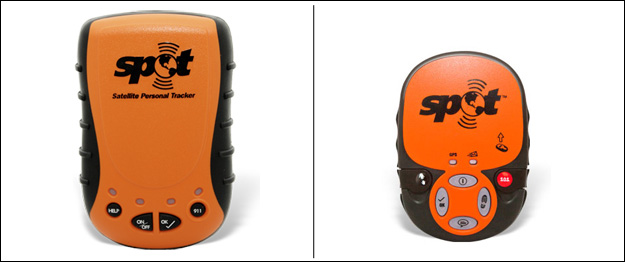
Review - SPOT Personal Location Beacon
The SPOT Rescue Beacons have been on the market since 2007 and are rapidly gaining popularity with paddlers in North America where many rivers do not have mobile phone reception.
There are now several different models available from SPOT. We will be looking at the SPOT Personal Tracker (pictured left) and the SPOT Satellite GPS Messenger (pictured right). There is also a SPOT connect, however as this relies on a smart phone & bluetooth connection as well as GPS in our view it is unsuitable for an emergency.
If you are thinking of buying a SPOT then we would recommend the GPS messenger (€179 plus €99 per year) as it is smaller and lighter than the Personal Tracker (€30 cheaper) and has covers on the SOS and Help buttons to prevent accidental operation.
The advantages:
- You do not need to waste time trying to explain what is wrong.
- You do not need to explain where you are.
- You do not need mobile phone reception.
- The SPOT is waterproof and shock resistant and takes normal AA or AAA batteries.
With both SPOTs you can send a SOS message, a Help Message, an OK message or just track your location similar to a normal GPS device. The OK message is a pre-programmed email or text message that is sent along with your GPS co-ordinates when the button is pressed to tell your friends or family that you are OK.
The Help Message is for non-life threatening emergency's which sends a message to your personal contact with you GPS co-ordinates so that they can come and help you. However they will not know what is wrong or what help you need.
In the event of a "life threatening emergency" pushing the SOS button will send a SOS message with your GPS co-ordinates to the GEOS International Emergency Response Center in the USA. If you have paid your membership fees they will then attempt to contact you to find out what the problem is. Even if that does not work they will contact the rescue services of the country you are in to tell them that you require help and provide them with your personal information and GPS location. All this takes 11 minutes from the time your SOS message reaches GEOS and so may or may not be quicker than a mobile call if you have reception and can talk the local language.
The Disadvantages:
- Make sure that you decide in advance of the trip what everybody considers to be a "life threatening emergency". Some people might want the wilderness experience to end if they have a broken toe or finger, where as others will want to tough it out and expect everyone else to do the same.
- You often will not be able to communicate with the rescue services that turn up (mostly helicopter rescue in the wilderness). They may well decide to pick up everyone and you might not have a choice in the matter.
- Rescue is just that, rescue. So do not expect to be able to take any of your equipment with you. For a large group this could end up being quite expensive.
- Make sure that you read all the small print in the contracts both from SPOT and GEOS and what they consider "a threat to human life or health as a result of an unforeseeable emergency" as well as all the exclusions: "Inadequate training or competence needed for your trip", "forecast change of weather", "emergency due to a pre existing or chronic condition" and an emergency "caused by a natural climate disaster".
- The following geographic locations are also excluded from rescue: North, Central or West Africa, Middle East, Iraq Iran and Afghanistan, Russia.
- Some countries like Russia, China and N. Korea tend to list GPS devices as Military equipment and as such could decide to imprison you on a spying charge if you happen to be in a sensitive boarder area.
Conclusion
Any device that can get outside help quicker when you really need it is always a good thing. We do however need to be clear that it detracts form the true wilderness experience, when we know rescue is just the push of a button away and might make us take more risks that we other wise would.
The OK button and tracking functions are great and make these devices something to get just for this function.
Users of these devices also need to fully understand where rescue will take place as the term "worldwide coverage" is somewhat misleading. The device will send out the signal but in a large part of our planet no one is going to actually come and rescue you. Before you travel to these countries you need to organize your own rescue plan, with an in-country contact person to set it in motion if needed.
Also the costs for the rescue need to be looked at. Which countries have state search and rescue is paid for, which do not and what happens if a private helicopter is sent as the free one was busy? Costs shouldn't matter if you have broken your femur and are bleeding to death, but for a dislocated shoulder you might think otherwise afterwards.
The best situation for everyone is to buy one and never have to use it. Peace of mind for you and your family that you are safe and well and that if something happens you have more options available to you.